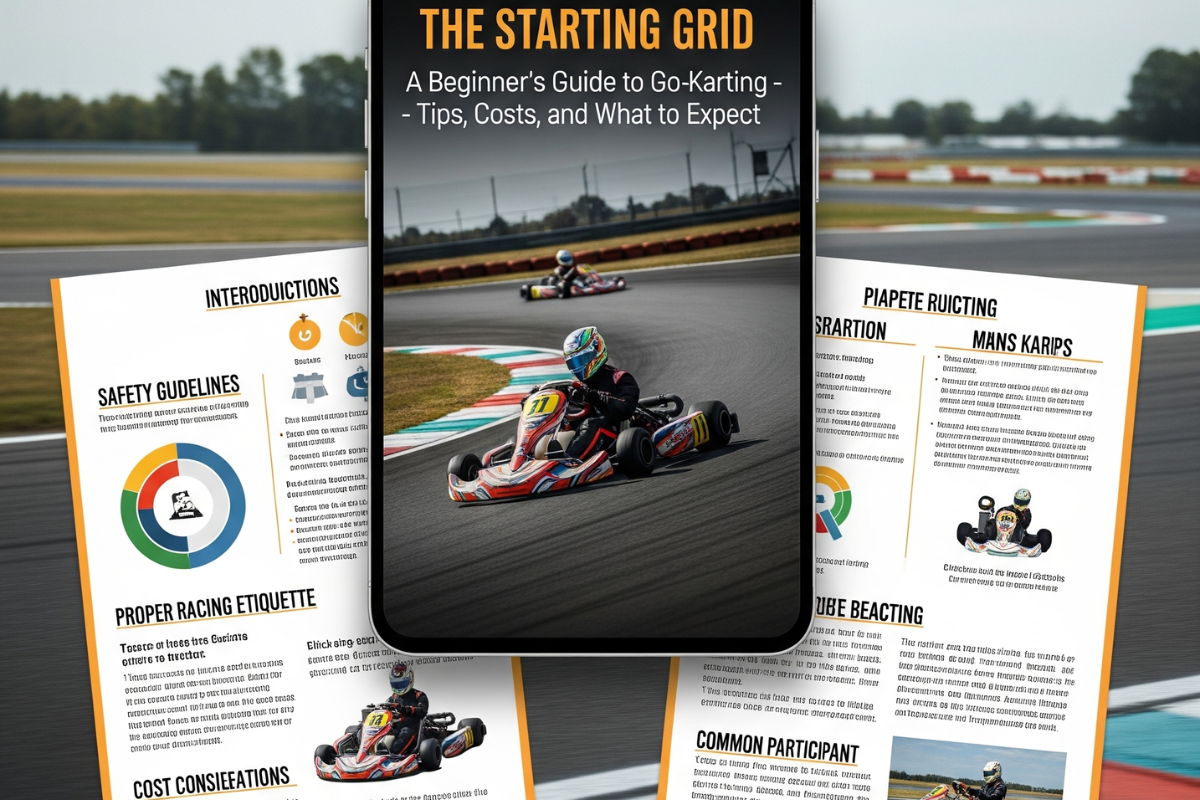The electrifying smell of rubber, the intense vibration of the engine beneath you, and the blur of the track as you speed by – go-karting offers an accessible and incredibly thrilling experience that ignites the inner racer in almost everyone. Whether you’ve dreamt of motorsports stardom or simply crave an exhilarating outing with friends and family, go-karting delivers a unique blend of adrenaline, competition, and pure fun. If you’re a first-timer, perhaps a bit curious but unsure where to begin, this guide is your green light to hit the track.
This comprehensive beginner’s guide will demystify the world of go-karting, covering everything you need to know from essential preparation and what to expect on race day, to crucial driving tips and a breakdown of typical costs. Get ready to transform your curiosity into confidence and embark on your first unforgettable go-karting adventure!
Why Go-Karting? The Thrill You Didn’t Know You Needed!
Go-karting isn’t just a leisure activity; it’s a dynamic experience with numerous appeals:
- Accessible Adrenaline: It provides a safe and controlled introduction to the sensation of speed and competitive racing, without the high barriers to entry of other motorsports.
- Skill Development: Beyond the fun, go-karting hones essential skills such as quick reflexes, hand-eye coordination, focus, strategic thinking, and decision-making under pressure.
- Social Fun: It’s an ideal activity for group outings, birthday parties, corporate events, or simply a friendly challenge among friends.
- Pure Excitement: The low-to-the-ground seating position amplifies the feeling of speed, delivering an exhilarating rush that’s hard to beat.
- Controlled Environment: Tracks are designed with safety in mind, featuring barriers, professional marshals, and well-maintained equipment.
Understanding Your First Go-Karting Experience: What to Expect
Your journey into go-karting typically follows a standardized process designed for safety and efficiency:
- Arrival & Registration:
- Early Arrival: Aim to arrive 30-60 minutes before your scheduled race time, especially if you’re part of a group. This allows ample time for paperwork and preparation.
- Waiver Forms: You’ll need to sign a liability waiver. If you’re under 18, a parent or legal guardian must sign on your behalf.
- ID Check: Be prepared to show identification, especially for age-restricted karts.
- Choose Your Package: Decide on the number of races or type of package you want (e.g., single race, multi-race package, group event).
- The All-Important Safety Briefing:
- Mandatory Attendance: Every first-time racer, regardless of age, must attend a safety briefing. Pay close attention! This is not optional.
- Key Information: The briefing will cover track rules, flag signals (crucial for safety!), how to operate the kart (accelerator, brake), and what to do in case of a spin-out or incident.
- Flag Meanings: Understand common flags like the yellow (caution, slow down), red (stop immediately), black (penalty/return to pits), and checkered (end of race).
- Gear Up:
- Helmet: A safety-approved helmet will be provided. Ensure it fits snugly and securely – it should not wobble.
- Balaclava (Hygiene Cap): Often, a disposable hygienic cap (balaclava) is provided to wear under the helmet. Always use it.
- Seatbelt: Learn how to properly fasten your kart’s seatbelt before you start.
- Optional Gear: Some tracks may provide or rent neck braces (especially for juniors), gloves, or racing suits.
- Kart Assignment & Familiarization:
- You’ll be assigned a specific kart.
- Once seated, familiarize yourself with the pedals (right for accelerator, left for brake – never push both simultaneously).
- If your feet don’t comfortably reach the pedals, or the seat feels off, ask a track marshal for adjustments. Your comfort ensures control.
- On the Track:
- Green Light: The race begins. Drive smoothly and adhere to all rules.
- Track Marshals: These staff members monitor the track, use flags, and are there to ensure safety and assist in case of incidents. Always follow their directions immediately.
- Post-Race:
- Lap Times: After the race, you’ll typically receive a printout or view a screen displaying your lap times, allowing you to compare with friends.
- Debrief: Some tracks offer brief debriefings or opportunities to ask marshals for driving tips.
Essential Tips for the First-Time Racer
To maximize your fun and minimize frustration, keep these practical tips in mind:
- Dress for Success (and Safety!):
- Wear comfortable, non-restrictive clothing. Avoid anything too baggy that could snag.
- Closed-toe shoes are mandatory. Sneakers or trainers with good grip are ideal. No sandals, flip-flops, or high heels.
- Tie back long hair securely so it fits entirely within the helmet.
- Remove loose accessories like jewelry or scarves.
- Pay Attention to the Briefing: This isn’t just a formality. Understanding the rules, especially the flag signals, is crucial for your safety and the flow of the race.
- Master Your Seating Position: Sit upright but relaxed, with your arms slightly bent. Place your hands on the steering wheel at the “9 and 3 o’clock” position for optimal control. Ensure your feet are comfortable on the pedals.
- Smooth Inputs are Key: Avoid jerky movements.
- Accelerate Gradually: Don’t stomp on the gas. Apply smooth, progressive pressure.
- Brake Progressively: Brake early and smoothly before a corner, then release as you turn in.
- Steer Smoothly: Gentle, controlled steering inputs are more effective than sharp turns.
- NEVER Use Both Pedals at Once: This is a critical safety rule and can damage the kart. If you’re braking, your foot should be off the accelerator, and vice-versa.
- Look Ahead on the Track: Don’t just focus on the kart directly in front of you. Look several kart lengths ahead, through the corner, and anticipate the movements of other drivers. This helps you plan your line and react safely.
- Understand the Basic Racing Line: The fastest way around a corner is generally to enter wide, “clip” the apex (the innermost point of the corner), and exit wide. For beginners, focus on consistency and smoothness over raw speed initially.
- Respect Others and Track Rules: No bumping, swerving, or aggressive driving. If you spin out, stay in your kart with your hands on the wheel, and raise your hand to signal a marshal. Never get out of your kart on the track unless instructed by a marshal.
- Stay Hydrated: Go-karting can be physically demanding, especially on outdoor tracks or during longer sessions. Drink plenty of water before and after your race.
- Focus on Fun, Not Just Speed: Your first time is about enjoying the unique experience. Don’t get discouraged if you’re not the fastest. Improvement comes with practice and familiarity.
Demystifying the Costs: What to Budget For
Go-karting costs vary widely depending on the facility, location, kart type, and number of sessions. Here’s a general idea of what to expect:
- Session Fees:
- Per-Race/Per-Session: Most common. A single race usually lasts 8-10 minutes. Expect prices to range from $20 to $50 per race.
- Package Deals: Almost all tracks offer discounted rates for purchasing multiple races (e.g., 2 races for $35-$70, 3 races for $50-$100+). These are often more cost-effective if you plan to do more than one race.
- Group Rates: Facilities offer special pricing for parties, corporate events, or large group bookings.
- Junior vs. Adult Karts: Junior kart sessions might be slightly cheaper or priced similarly.
- Mandatory Extras:
- Annual License/Membership Fee: Some tracks require a small, one-time or annual fee (e.g., $5-$10) for insurance purposes or to track your lap times across visits.
- Balaclava (Hygiene Cap): Often a small fee (e.g., $2-$5) or included in the package.
- Optional Extras:
- Gloves: Can be rented or purchased (e.g., $5-$15).
- Go-Pro/On-board Camera Rental: If available, for capturing your race.
- Arcade Games/Food/Drinks: Many facilities have arcades or snack bars where you might spend extra.
Average Cost Expectation: For a solid first experience (2-3 races), budget anywhere from $50 to $150 per person, depending on the track’s pricing structure and whether you opt for extras. Always check the specific track’s website for their current pricing.
Tips for Saving Money:
- Look for weekday specials or off-peak hours, which are often cheaper.
- Book online, as some tracks offer a small discount for advance reservations.
- Inquire about loyalty programs if you plan to become a regular.
Choosing Your Track: Indoor vs. Outdoor Considerations
Your choice of track can significantly influence your first experience:
- Indoor Tracks: Generally offer a more controlled environment (no rain, consistent temperature), often featuring more technical turns and slightly less overall speed. This can be great for beginners to focus on technique.
- Outdoor Tracks: Tend to be larger, with longer straights and more open turns, allowing for higher speeds and a more realistic racing feel. They are subject to weather conditions.
Research reviews and available kart types to pick a facility that matches your comfort level and desires for your first time.
Your Green Light to Go-Karting Fun!
Go-karting is an incredibly accessible and thrilling adventure waiting to be experienced. By understanding what to expect, preparing appropriately, and applying these essential driving tips, you’re set for a fantastic first time on the track. Don’t let uncertainty hold you back from this adrenaline-pumping activity. Factor in the costs, choose your track wisely, and get ready for the pure joy of speed and competition. The checkered flag is calling your name – embrace the excitement and start your racing journey today!
https://acekarts.com.au/pits/race-hq/8-tips-on-how-to-drive-a-go-kart-for-the-first-time

Ramon Splinter is a passionate go-kart enthusiast and expert who shares valuable tips and insights on Zyorb, a blog dedicated to karting enthusiasts. With years of experience on the track, he specializes in helping beginners and seasoned drivers improve their skills, optimize their karts, and master racing strategies. His articles combine technical knowledge with practical advice, making go-karting more accessible and exciting for all.

